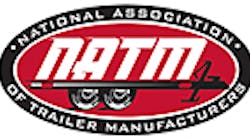TRAILER manufacturers are slightly more cautious this year than a year ago, according to a survey conducted in January by McGladrey.
Forty-four percent said they expect to be thriving/growing, 49% said they should be able to hold their own compared to 2013, and 5% expect a declining business. Heading into last year, the numbers were 65% thriving/growing, 25% holding their own, and 8% declining.
However, compared to the general economy, trailer manufacturers were much more hopeful in terms of growth prospects for 2014: 11% of trailer manufacturers are very optimistic (compared to 2% in the general economy), 72% somewhat optimistic (70% general economy), and 11% somewhat pessimistic (23% general economy).
“What’s very interesting is that there are no respondents feeling very pessimistic, whether it’s about their industry or the economy in general,” said Tim Koch, partner of Assurance Services for McGladrey. “I’m a CPA. We’re pessimistic by nature. If you ask me how I feel, I feel somewhat pessimistic. I think 2014 will be pretty good. I think it will expand on what we did in 2013, but there are a lot of uncertainties in 2014.”
The 2012 industry benchmarks for net income were 79% growth for trailers and 74% growth for assemble-to-order manufacturers.
“There was continued strengthening in 2013,” Koch said. “It’s been a great run, but how high can we go? Margins are tightening, there are increased inventory levels, qualified employees are difficult to find, there has been supplier base consolidation, government regulations are having an effect, and there are macroeconomic pressures.”
In revenue, the 2012 industry benchmarks were 25% percent for trailers (compared to 30% in 2011) and 24% for assemble-to-order manufacturers. Revenue growth continued in 2013, ranging from 10% to 20%. The lower-end, less-complex products are still in highest demand, with continued improvement for the higher-end product. Sixty-six percent of respondents increased sales prices in 2013, with 60% increasing prices 1% to 5% and 6% increasing prices 6% or more.
Koch said lending levels are back to pre-recession levels, with OEM loosening of covenants and other restrictions, and banks taking more chances. Floor plan sources are available for most dealers and manufacturers.
Dealers/customers still control the buying cycle, he said.
“Dealer loyalty is still lacking, compared to other industries,” he said. “End customers are buying on price, not brand. Manufacturers are having trouble getting past the commodity label.”
In terms of revenue growth for 2014, 58% of trailer respondents are expecting 1% to 5% growth, 17% are expecting 15% to 20% growth, and 25% are expecting 20% or more growth. Other industries: RV, 6% growth in 2014; and marine, 5% to 10% growth.
How will they get there?
Ninety-two percent of respondents are greatly or somewhat relying on increased product offerings; 100% are greatly or somewhat relying on increased sales to current customers; and 97% are greatly or somewhat relying on acquisition of new customers (compared to 98% in 2013).
He said there is an increased opportunity for dealer floor plan arrangements. The percentage use by the trailer industry lags behind other industries. For traditional sales: 50% on COD terms; 42% on one- to 30-day terms; and 8% on 30-plus-day terms.
There is increased opportunity for OEM differentiation through targeted dealer programs. There are important margin considerations: 8% of respondents use interest reimbursement programs; 16% use volume rebate programs; and 50% use discounting programs.
Ninety-two percent of respondents indicated that product quality is important to dealer loyalty; 42% indicated that brand name is important to dealer loyalty; and 33% indicated that product price is important to dealer loyalty.
Koch cited a quote on raw materials by Dale Billet from the 2013 M&D Monitor Report: “Cost increases in raw material commodities (steel, lumber, aluminum and the like) have been relatively moderate after years of volatility. The improving US and global economies and the corresponding reduction in excess capacity worldwide will likely result in pressure to increase prices—and commodity price increases will have ripple effects through a wide range of industries and products.”
Koch said inventory pricing retracted slightly in 2013, for the second year in a row, with 2012 materials to sales at 60.8%.
He said aluminum inventories remain high and demand has not been strong, with prices decreasing overall during 2013. Capacity is continuing to increase both in China and throughout the rest of the world in a market that is operating well below capacity.
“In terms of the 2014 outlook, aluminum prices are below the cost of production in most areas and prices will most likely rise 2% to 5%,” he said.
Strong momentum in the auto sector has supported prices for steel in 2013 and will remain strong for the first half of 2014, he said. Steel-pricing sustainability will depend on improvement in demand worldwide versus increasing capacity, no further deterioration of the Eurozone debt crisis, and raw material pricing.
“Continued recovery of the construction market in the US will contribute to global demand,” he said. “Steel capacity in Europe and China will remain well above demand.”
In 2013, overall steel pricing fluctuated during the year but finished down approximately 1% overall for the year. In 2014, prices are expected to decrease 5% to 10% worldwide this year due to China—with 49% of the world steel capacity—continuing to increase capacity and rebalancing its economy in a slow market.
Foreign sourcing continues to lag behind other industries, he said, with 33% of respondents using foreign-sourced raw materials and 63% decreasing foreign-sourced materials. He said 65% expect to increase inventory levels by 1% to 20%.
Employee productivity remains at a high level. Employee fatigue and growth have led to increased employee levels in 2013. Employee and skill shortages continue, with 58% of respondents believing shortages will significantly limit or limit growth in 2014; 65% indicating that they were able to find skilled talent only some of the time or rarely; and 50% indicating that a workforce skills gap led to decreased productivity.
To attract new employees, 54% are increasing compensation (base or incentive), 15% are focusing on quality-of-life matters, and 23% are not attracting new employees and are using overtime to compensate for lack of quality employees.
He said 53% plan to expand capacity in 2014 (compared to 52% in 2013).
Tax update and tax planning ideas
Chris Bradford, partner of Tax Services for McGladrey, said that despite an increase in tax rates, companies can take advantage of various planning opportunities: income and deduction timing; cost segregation studies (new and pre-existing real estate); accounting method changes; business restructuring; tax elections; LIFO; IC-DISC; R&E credit; and tangible asset and repairs studies.
He said LIFO allows companies to deduct the inflation impact to inventory cost. For example, with an inventory of $3 million that increases $250,000 annually at 3% inflation, the first-year benefit is a $90,000 deduction and the fifth-year cumulative benefit is $525,000 of deductions. ♦












